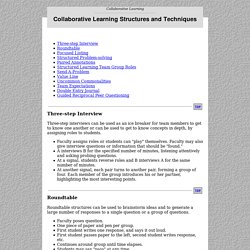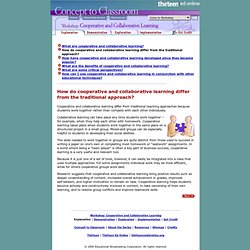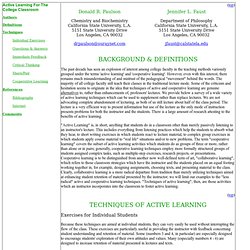

Collaborative Learning Structures and Techniques. Three-step Interview Three-step interviews can be used as an ice breaker for team members to get to know one another or can be used to get to know concepts in depth, by assigning roles to students.

Faculty assigns roles or students can "play" themselves. Faculty may also give interview questions or information that should be "found. " A interviews B for the specified number of minutes, listening attentively and asking probing questions. At a signal, students reverse roles and B interviews A for the same number of minutes. Roundtable Roundtable structures can be used to brainstorm ideas and to generate a large number of responses to a single question or a group of questions. Faculty poses question. The key here is the question or the problem you've asked the students to consider. Once time is called, determine what you want to have the students do with the lists...they may want to discuss the multitude of answers or solutions or they may want to share the lists with the entire class. Cooperative Learning. Is a successful teaching strategy in which small teams, each with students of different levels of ability, use a variety of learning activities to improve their understanding of a subject.
Each member of a team is responsible not only for learning what is taught but also for helping teammates learn, thus creating an atmosphere of achievement. Students work through the assignment until all group members successfully understand and complete it. Cooperative efforts result in participants striving for mutual benefit so that all group members: gain from each other's efforts. (Your success benefits me and my success benefits you.) recognize that all group members share a common fate. Know that one's performance is mutually caused by oneself and one's team members. Feel proud and jointly celebrate when a group member is recognized for achievement.
Research has shown that cooperative learning techniques: promote student learning and academic achievement. Cooperative and Collaborative Learning: Explanation. How do cooperative and collaborative learning differ from the traditional approach?

Cooperative and collaborative learning differ from traditional teaching approaches because students work together rather than compete with each other individually. Collaborative learning can take place any time students work together -- for example, when they help each other with homework. Cooperative learning takes place when students work together in the same place on a structured project in a small group. Mixed-skill groups can be especially helpful to students in developing their social abilities.
The skills needed to work together in groups are quite distinct from those used to succeed in writing a paper on one's own or completing most homework or "seatwork" assignments. Because it is just one of a set of tools, however, it can easily be integrated into a class that uses multiple approaches. Cooperative Learning Institute And Interaction Book Company. Active and Coopeative Learning. The past decade has seen an explosion of interest among college faculty in the teaching methods variously grouped under the terms 'active learning' and 'cooperative learning'.

However, even with this interest, there remains much misunderstanding of and mistrust of the pedagogical "movement" behind the words. The majority of all college faculty still teach their classes in the traditional lecture mode. Some of the criticism and hesitation seems to originate in the idea that techniques of active and cooperative learning are genuine alternatives to, rather than enhancements of, professors' lectures. We provide below a survey of a wide variety of active learning techniques which can be used to supplement rather than replace lectures. We are not advocating complete abandonment of lecturing, as both of us still lecture about half of the class period. "Active Learning" is, in short, anything that students do in a classroom other than merely passively listening to an instructor's lecture.